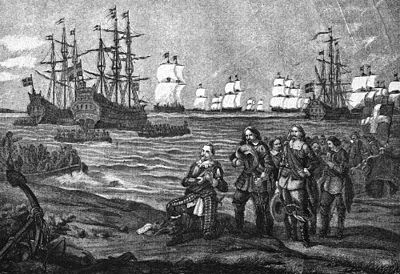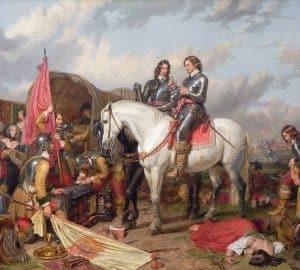
After landing in northern Germany Gustavus Adolphus had a strong army and funding from France, but he lacked German allies. He wanted to fight for the German Protestants, but they were not so sure they wanted to join him. They were more interested in using the presence of the Swedish army as a threat in their discussions with the emperor. The imperialists were not in any hurry to fight the Swedes, as they hoped that the Swedish discipline would fall apart, and they would anger their German allies. It was over a year from Gustavus’ landing to the first main battle.
As Adolphus worked his diplomacy with the Germans, one city he formed an alliance with was Magdeburg. The city’s Protestant population had risen against the Catholics during the war, and now they signed a treaty with Sweden for protection. However, it was not long before the army of the Holy Roman Empire, under the County of Tilly, arrived and lay siege to the town. According to the terms of the alliance, it was Gustavus’ duty to relieve Magdeburg, and it was doubly important that he do so, as it would show the hesitant German princes that he was serious about protecting them. In this he showed his honesty, as he worked to fulfill his treaty instead of seeking more conquests for himself.

The Swedish king could not go to the help of Magdeburg without securing his rear. He had to first win the Electors of Brandenburg and Saxony as allies, to ensure he was not attacked in the rear. Diplomacy dragged out, and Gustavus became frustrated, as time was running out for Magdeburg. He used harsh words with George William of Brandenburg:
I tell you plainly I will hear not a word of neutrality. Your Serenity must be either friend or foe. As soon as I get to your frontier you will have to declare yourself. Here strive God and the devil. If you will hold with God, come over to me, If you prefer the devil, you will have to fight me first. Tertium non dabitur [There is no third choice,] of that you may be sure.
Finally the electors were convinced by Adolphus’ promises and threats. Treaties were signed, but the Swedes were not able to reach Magdeburg in time. The city fell on May 20, 1631. In the ensuing confusion the city was lit, and the imperial soldiers began to loot and kill. By the time they left the city, it was a burnt rubble. Only 5,000 of 30,000 civilians remained alive. News of the sack of Magdeburg, as it was called, was received with horror by Protestants across Europe. It was good publicity for Gustavus, and he had pamphlets printed declaring that this is how the Emperor Ferdinand planned to treat his Protestant subjects. It intensified the war, and in future engagements the Protestants threatened the Catholics with “Magdeburg quarter.”
After capturing Magdeburg, Tilly next decided to invade Saxony, which up to that point had not been ravaged by war. This drove John George of Saxony to ally with the Swedes. They united their armies, and set out to engage the Imperialists.

Battle of Breitenfeld
The two armies met at Breitenfeld, just north of Leipzig on September 17, 1631. The Protestants had 42,000 men, the Imperialists, 35,000. Although Tilly had fewer men, he had more that were well trained. There were 9,000 untrained Saxons present, which contributed little to the fight. The Saxons were positioned to the left of the Swedes, and Gustavus put most of his cavalry on his right.

After a few hours of artillery bombardment the battle began in earnest with the Imperial cavalry attacking on both flanks. Seven times the Black Cuirassiers charged the Swedish lines, but each time they were driven back by the steady fire. On the other flank, the untrained Saxons were broken. John George ingloriously led his men in their retreat. Tilly seized this opportunity, and sent most of his infantry to pursue the Saxons, and strike the now vulnerable Swedish left.

Abandoned by his Allies, Gustavus ordered his second line, under Gustav Horn, to realign and meet this threat. Meanwhile the Swedish cavalry, with the king himself at their head, charged the Imperial left. When Tilly had ordered his infantry to attack, he had left his artillery unprotected. The Swedish cavalry captured these with little difficulty, and turned them to fire into the flank and rear of the Catholic infantry. The Imperialists, unable to break Horn’s line and under heavy fire from several directions, broke after several hours of bloody fighting. In that night’s retreat the Catholic army completely disintegrated. They lost 7,600 killed, 3,000 wounded and 12,400 captured. Thousands more deserted and never returned to the army. The Swedes lost 3,550 killed and the Saxons 2,000.

In this brilliant victory Gustavus Adolphus had eliminated the main Catholic army. He was hailed as a hero by Protestants all over Europe. He was called “The Lion of the North and the Bulwark of the Protestant Faith.” However, the thirty years war was far from over.
Sources
The Thirty Years War by C. V. Wedgwood
Gustavus Adolphus and the Struggle of Protestantism for Existence by C. R. L. Fletcher





There are too many insecure matters here to be addressed shortly.
Just to know: We call it the 6th of November, although that’s not a fault. Today However, most of our World, and people even at the time of this King, use the Julian calendar.
I have read all the sources, but not the one by Wedgwood above because his wasn’t reliable at the time.
Now: The size of the armies. They were mostly at least about 30.000 or more. Gustaf landed 32.000 at Usedom but recruited many men along his course, as well as he lost soldiers; at Breitenfeld to mention a more known product of the Thirty Years War, he lost about 4000.
When at Lützen he had about 35.000 in total, and a guess at another 40.000 as “followers” which at the time were a moving spectacle only living in the wake of those enormous armies as they wasted cities and farms dry for years.
– Then to battle: No morning mist was lifted. Over the fields of Mars there was nothing to see.
– Gustaf didn’t use metal armor, but the thick elk hide he wore worked very well at distance against floppy musket bullets.
– Rumors about his death didn’t spread “fast”. First of all it was early nightfall in the end of the day of battle. Still with little sight of anything. Mostly dead or whining in smoke and the dark of night. Second; chain of command was very slow when you lost important officers. Main Center, Sweden’s most famous soldiers called “The Yellow”, were totally destroyed.
Plus, even when the news came, it was probably hushed away at first.
It wasn’t until the day after people started to realize.
We know pretty much about his personal life, although not as intimate as readers always want hundreds of years later…